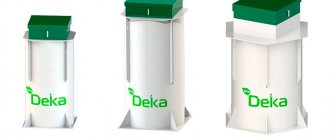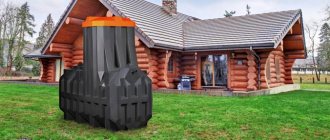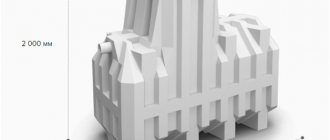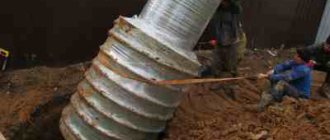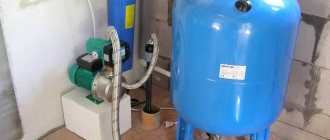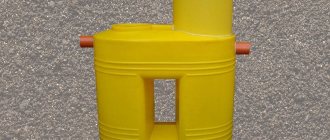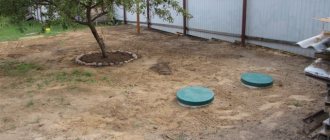The Triton septic tank is a durable plastic storage tank. According to the principle of operation, the Triton septic tank resembles a classic cesspool. The tank consists of three chambers, where in each the process of decomposition of biological material takes place by settling solid particles to the bottom. Purified water enters the filtration platform.
The storage septic tank operates autonomously. The service life of the tank is up to 50 years. The Triton septic tank model range is represented by tanks of various volumes: from 2 to 40 m3. The degree of wastewater treatment is no more than 60%. When using additional equipment - an infiltrator or an aeration field, the purification level reaches 90%.
The Triton storage septic tank is designed for collecting waste and decomposition. Processing occurs with the help of anaerobic bacteria. During the life of microorganisms in the septic tank, carbon dioxide and hydrogen sulfide are released. Gases are removed from the septic tank through ventilation. The accumulated sediment must be periodically pumped out using a sewer truck. The frequency of pumping depends on the number of people living in the house.
In what cases is a storage type septic tank used?
The Triton septic tank is made of polypropylene or polyethylene. The material is resistant to corrosion, which increases the service life up to 50 years. If there are stiffening ribs, its strength is not inferior to a metal tank. When choosing a plastic septic tank, you should carefully inspect the seams of the container; it is also important that the neck is high enough and wide enough. Experts recommend installing two plastic septic tanks at once, combined into one storage system. The use of a septic tank of this model is justified:
- If visiting the dacha is seasonal.
- In case it is impossible to install an additional post-filtration system.
- The size of the summer cottage does not allow the installation of a more advanced wastewater treatment system.
- High location of groundwater.
When choosing a septic tank for your dacha, you should take into account that the Triton septic tank is designed for seasonal operation, otherwise you will often have to resort to the services of a sewer truck or install an additional tank. In any case, you will have to pump out waste from the storage septic tank once every 1-3 years, depending on the model.
Advantages of Triton septic tanks:
- Affordable price.
- Wide selection of septic tank modifications.
- Energy independence.
- Relative ease of installation of the system.
- Long service life.
- The tank is cleaned 1-3 times a year.
Disadvantages of the Triton septic tank:
- Without the use of additional equipment in the form of an infiltrator or an aeration field, the level of purification reaches no more than 60%.
- If the sewer drains are sufficiently dirty, it is necessary to frequently clean the infiltration fields.
When choosing a specific septic tank model, you need to consider where the treatment plant will be installed. If a septic tank is installed on a summer cottage where residents are expected to live temporarily, then a storage type will be sufficient for wastewater treatment. If a treatment plant is necessary for a country house with permanent residence, then it is recommended to use other systems - energy-dependent ones.
Installation
Since the Tank and Triton septic tanks are produced by the same company, their installation is very similar. The manufacturer recommends that the small vertical Mini and Microb models should not be anchored, but placed on a 10 cm layer of sand. Larger T-grade containers should be placed on a poured (installed) reinforced concrete slab. The procedure for installing small septic tanks is as follows:
- We dig a pit 30-35 cm larger than the dimensions of the container. In depth, it should be 10 cm deeper. When determining the depth, keep in mind that the lid must be on the surface.
- We dig trenches for sewer pipes - inlet from the house and outlet - to the post-treatment device. If you use plastic pipes with a diameter of 100 mm, they must run with a slope of at least 2 cm.
- The bottom of the pit is leveled and compacted (tamper to high density). Sand is poured onto the compacted soil in a layer of 5 cm, leveled and spilled. Then, in the same way - the second layer. It is leveled.
Installation diagram of the Triton Microbe septic tank - They install the septic tank, check whether it is level by placing a level on the neck. It is necessary to check in all planes.
- Connect the pipes.
- Pour water into the container. When its level reaches 20-25 cm, we begin backfilling.
- They begin to fill the distance between the walls of the pit and the container with a mixture of sand and cement. For 1 part cement take 5 parts sand. The gap is filled with this mixture in layers of 20-30 cm. Lay the mixture around the circumference (perimeter), compacting thoroughly. It is prohibited to use equipment for compaction - only manual compaction. The entire gap is filled layer by layer. When working, make sure that the water level in the septic tank is 25-30 cm above the backfill level.
- Having reached the horizontal surface, insulation is laid on the body. This is usually polystyrene foam. The density needs to be high - it should not be crushed under the mass of earth that will be laid on top. The thickness depends on the region; for Central Russia 5 cm is enough.
- Geotextiles can be laid on top. It will prevent roots from growing into the insulation and destroying it.
- Next, everything is covered with “native” soil.
Features of installation of large containers
This is the entire process of installing a small septic tank - Mini and Micro. If we are talking about installing Tver-T or Tver-N, a reinforced concrete slab is installed/poured at the bottom of the pit after a layer of sand (do not forget to adjust the depth of the pit). There should be loops on the slab to which a ribbon-type cable is tied (regular ones are not suitable - they cannot withstand the load). These cables tie the septic tank to the slab - anchor it. This is a way to protect yourself from the floating of an empty septic tank when the groundwater level is high.
It is better to place such containers on a concrete slab.
After this, backfilling begins. In general, special attention must be paid to the backfill - there should be no foreign inclusions in the sand. The quality of the backfill determines whether your septic tank will stand or be crushed. Most of the destroyed septic tanks were installed with violations. And the main thing is large pieces of foreign rock in the backfill.
The sand-cement backfill, under the influence of moisture from the soil, turns into a sarcophagus, which keeps the container from floating and protects its walls from rock pressure. If there are gaps in this protection, water seeps in, erodes the protection and sooner or later destroys the container.
Anchoring example
The lineup
The manufacturer offers a wide range of models. Each model differs in performance designed for a certain number of people. Before choosing a particular model, study the available options.
- Triton - Mini.
- Triton-ED.
- Triton-T.
When choosing a Triton septic tank, the peak value of liquid discharge into the sewer is taken into account. If a family consists of three people, then an additional three people must be included in the calculation, then the peak load on the septic tank will be sufficient.
Triton-Mini
The Triton septic tank of this model has a two-chamber design. The compartments are connected to each other by upper and lower pipes. In the first chamber, the liquid settles and flows into the second. It is enough to clean the tank once every 3 years. If you add anaerobic bacteria, then cleaning is enough to be done once every 5-6 years.
Weight: 70 kg. Number of users: 1-2 people. Salvo discharge: 150 l Volume of liquid processed: 0.25 m3/day. Energy dependence: No Degree of purification: 0% Water consumption per person: 250 l/day. Necessity of preservation for the winter: Yes
The plastic body of the septic tank is resistant to temperature changes down to minus 30°C. As additional equipment, the Septic Triton 400 infiltrator is used, which further purifies the liquid leaving the septic tank. Triton-Mini is designed for a family of 2-3 people. The daily volume of liquid that a septic tank can take is no more than 600 liters. Receiver volume 750 liters.
Triton-Ed 1.8
The capacity of this Triton septic tank model is divided into two working chambers. In the first chamber, the liquid settles and heavy particles settle to the bottom. Water, purified from large fractions, flows into the second chamber, where it is further purified. The Triton-ED septic tank is designed for a family of 2-3 people.
Weight: 75 kg. Number of users: 1-3 people. Salvo discharge: 1.8 l Volume of liquid processed: 0.6 m3/day. Energy dependence: No Degree of purification: 65% Water consumption per person: 250 l/day. Winter preservation: Yes.
The Triton ED series septic tank is a storage tank, where wastewater is treated by treating it with anaerobic bacteria. Purification degree 60%. For higher purification, it is recommended to use additional equipment - an infiltrator. The septic tank is preserved for the winter. In spring, water and bacteria are added.
| Triton-Ed model | Productivity, lit/day. | Number of people | Volume liters |
| 1800 vertical | 600 | 1-3 | 1800 |
| 2000 horizontal | 700 | 3-4 | 2000 |
| 3500 horizontal | 1200 | 4-6 | 3500 |
Instructions for use ↑
According to the instructions, when operating a septic tank, the following rules should be observed:
- limit or prevent chemicals that destroy bacteria from entering the septic tank;
- To wash dishes, use gentle detergents in the form of liquid or gel. Avoid using aggressive substances, varnishes or paints. If there is a need to use such means, for example, to clean complex contaminants, then such wastewater should not be poured into the sewer;
- To prevent bacteria from dying, when excommunicating from a country home for a period of more than one month, the liquid should be pumped out from the septic tank. Then fill it with water to 1/3 of the total area. Upon returning home, add bacteria to the container and fill it with water;
- Once every 6 months it is necessary to stir the mass that accumulates at the bottom of the septic tank. This avoids the growth of bacteria on the internal walls of the equipment.
Principle of operation
Any device from Triton is equipped with biological filters with aerobic bacteria. They purify moisture, saturating it with useful substances, which allows the liquid to be used as a fertilizer for the soil. Before water is purified by biofilters, it settles in a storage tank for several days.
When the liquid enters the container, it is immediately cleared of solid particles by gravity. This is called post-purification. In most cases, this stage takes 1 to 2 days. Pre-purified water flows through the infiltrator into the next section, passing through several mechanical filters. The moisture stays here for several hours. Afterwards, it is forcibly pumped into the next compartment with bacteria, and if the level of purification meets the requirements, the installation sends water into the ground. The soil filter stops residual particles that were not eliminated in previous stages.
Advantages of Triton:
- Easy to install and maintain;
- Availability. The price of the Triton-Micro septic tank is $200 without installation;
- Efficiency and high performance. During a day, with intensive work, the simplest system can clean up to 500 liters, more advanced models - up to 1000. These are very high figures, especially if fast work is required;
- All models can be used in the harsh conditions of the Russian climate. Production takes into account the deep level of soil freezing, high groundwater and other problems.
Photo - characteristics
But, Triton septic tanks also have certain disadvantages :
- The first settling can take up to 3 days, minimum – 2 days in the Mini model;
- The minimum distance from the facade should be 6 meters, from the nearest water source - 50. This is a mandatory requirement, but not every yard has the opportunity to install a storage tank at such a distance;
- Additional cleaning required once per semester. Sludge, solids and other debris clog filters and reduce efficiency. Therefore, you need to periodically clean the system. Also, the microbiological filter needs additional bacteria.
Video on the topic:

